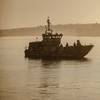source: ‘The World Floating Production Report II’, Douglas-Westwood & Infield Systems
Over the past five years capital expenditure on floating production systems has totalled some $20 billion, but over the next five years this is forecast to increase by more than 50% to $32 billion. Annual spend is expected to soar to over $9 billion in 2004.
These are amongst the findings of a major new study launched today at Houston’s annual Offshore Technology Conference by energy analysts Douglas-Westwood and industry data specialists Infield Systems.
The analysts forecast that West Africa will get the lion’s share of future investment in floaters, with investments of some $11 billion destined for the region. This is nearly twice the spend in the other major regions with the Gulf of Mexico at $6.1 bn., Brazil at $5.1 bn and Asia Pacific at $4.7 bn.
In total, some 134 floaters are expected to be installed over the period 2002-2006. The largest number, 91, are expected to be FPSOs, 14 are floating production semi-submersibles, 14 SPARs and 15 TLPs. Expenditure on FPSOs is expected to total nearly $21 billion of the $32 billion total, the remainder being divided fairly equally amongst FPSSs, SPARs and TLPs.
“204 floating production systems have been deployed worldwide to date,” said Infield Systems data manager Dr Roger Knight “and 108 are FPSOs. Of these, 74 are currently operational with another five under construction, seven in conversion and firm plans for a further 12. It is interesting to observe the change in geographic segmentation over the years, in particular the decline of the European market and the rise of West African market.”
According to the study’s lead analyst, Dominic Harbinson of Douglas-Westwood, “the greatest challenge is in trying to forecast the future mix of FPSOs with field operators having the choice between investing in a newbuild, converting a tanker hull, or re-furbishing one of the existing fleet. Over the period we expect to see at least 24 newbuilds, plus 35 conversions and 32 upgrades. However, a combination of high oil prices and a shortage of tanker hulls could increase the share of newbuilds. A further consideration must be the research currently underway by companies such as Aker and ABB on new hull shapes and how long this will take to materialise into new floaters.”
Featured videos

Inmarsat Enhances Service to Drive Digitalization

Tracking Foreign Vessels Working in the U.S. Jones Act Market

Inside the Electrified Truckable Tug
Subscribe for
Maritime Reporter E-News
Maritime Reporter E-News is the maritime industry's largest circulation and most authoritative ENews Service, delivered to your Email five times per week









